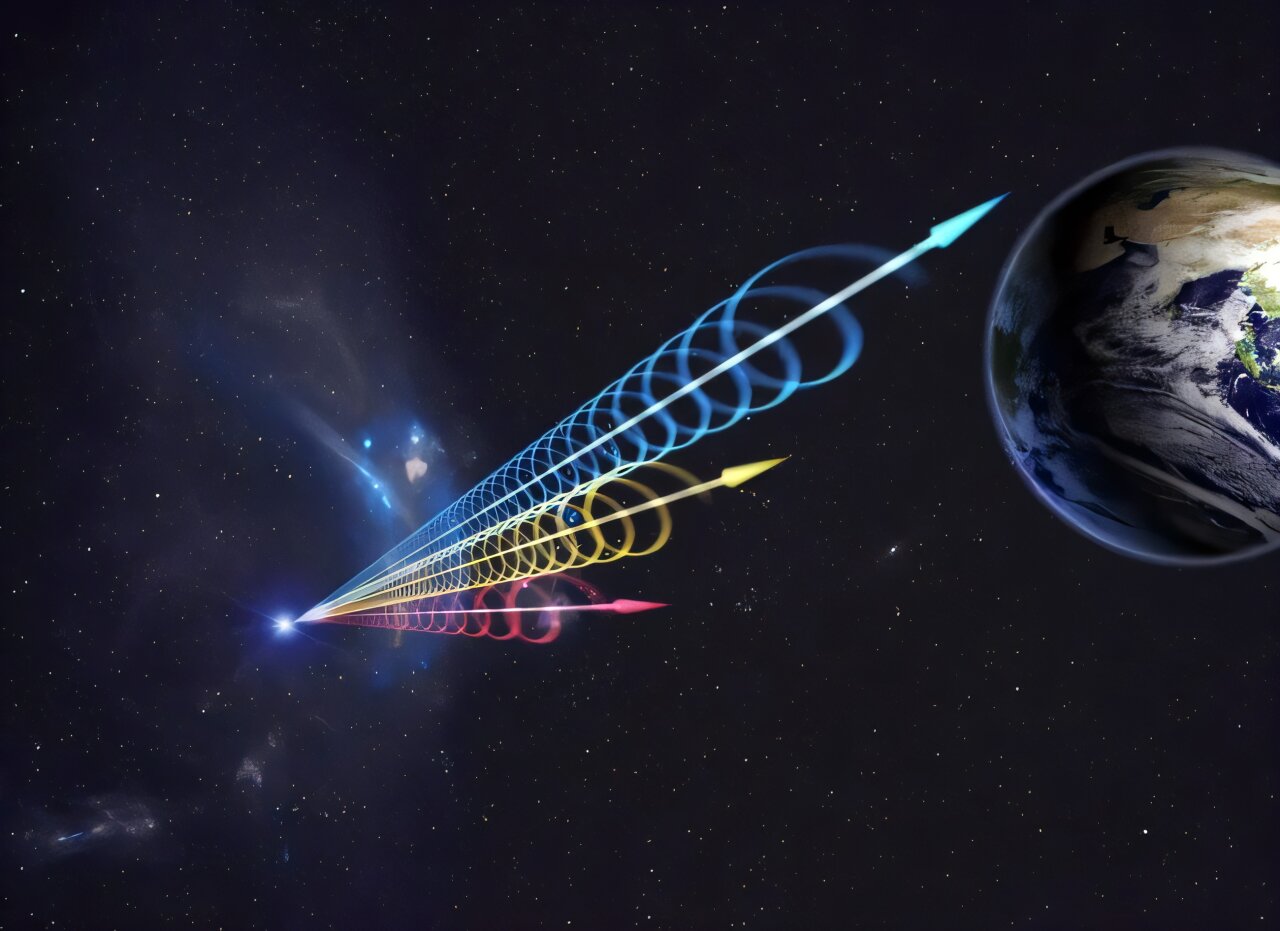Follow us on Google News (click on ☆)
Russian astronomers detected this signal with the LPA radio telescope, which scans the sky at a frequency of 111 MHz. This flash, brief yet extraordinarily powerful, seems to originate from a distant region of our Universe.

An artist's impression of a fast radio burst (FRB) reaching Earth. The colors represent different wavelengths.
Credit: Jingchuan Yu, Beijing Planetarium.
Fast radio bursts (FRBs) have been a source of intrigue since their discovery, and their characteristics, including a dispersion typical of pulsars, resemble known phenomena without being directly connected to them. Possible causes? Theories range from young magnetars exploding in supernova remnants to cosmic strings, and even the possibility of a technosignature—a sign of extraterrestrial technology.
FRBs appear as fleeting pulses lasting between 0.08 and 26 milliseconds. Their dispersion measure typically ranges from 109 to 2,600 pc/cm³, a characteristic that makes them detectable by highly sensitive instruments, such as the LPA radio telescope, which specializes in metric wavelengths.
Led by Sergey Tyul'bashev, a team from the Pushchino Radio Astronomy Observatory detected this unique signal as part of the PUMPS (Pushchino Multibeams Pulsar Search) project. The discovery occurred during a technical check of the observation capabilities of the LPA at the Lebedev Physics Institute (LPI).
This signal, lasting 211 milliseconds, has a dispersion measure of 134.4 pc/cm³ and a peak flux density reaching 20 Jy. This high dispersion appears to suggest an extragalactic origin, located about 2.3 billion light-years away.
According to the team, the signal's power places this event among the most intense FRBs ever detected. Designated FRB 20190203, this burst is only the second observed at such a low frequency as 111 MHz, but it is the first of its kind to show no repetition.
The most likely theory proposed by the researchers is that of a synchrotron maser emission generated by a magnetar—a highly magnetized neutron star. This hypothesis aligns with the observed properties of FRB 20190203, though further studies are needed to verify this possibility.
If confirmed, FRB 20190203 would become the first extragalactic FRB discovered as part of the PUMPS project. For now, no gamma-ray emission has been associated with this signal, leaving the exact mechanisms involved still shrouded in mystery.
What is a fast radio burst (FRB)?
Fast radio bursts, or FRBs, are sudden, very brief radio pulses first discovered in 2007. These phenomena, which last mere milliseconds, emit an immense amount of energy.
Though their exact origin remains unknown, some hypotheses include extreme events such as magnetars—neutron stars with intense magnetic fields. Another possibility is that they result from shock waves in supernova remnants, where colliding particles could generate this type of signal.
FRBs are ephemeral and unpredictable. Most radio telescopes struggle to detect these signals because they generally do not repeat. Their dispersion measures, which vary depending on distance, add further complexity to pinpointing their exact location.
Highly sensitive radio telescopes, such as the Large Phased Array (LPA) in Russia, are capable of capturing FRBs. These types of instruments operate at specific wavelengths, allowing them to identify these signals despite their short duration and dispersion.
What is a jansky (Jy)?
The jansky (Jy) is a unit of measurement for flux density in radio astronomy, used to express the intensity of radio emissions from astronomical sources. It is defined as being equal to 10⁻²⁶ watts per square meter per hertz (W/m²/Hz).
Celestial radio sources, such as pulsars and distant galaxies, emit signals that are often very faint but measurable over vast distances. The jansky enables astronomers to standardize the quantification of these emissions, even for extremely weak signals.
The jansky is used to compare the intensity of signals emitted by various sources. For instance, a flux of 20 Jy, as observed in the fast radio burst FRB 20190203, indicates a high power level. The sensitivity of radio telescopes is often expressed in mJy (milli-jansky) or µJy (micro-jansky) to detect even weaker sources.